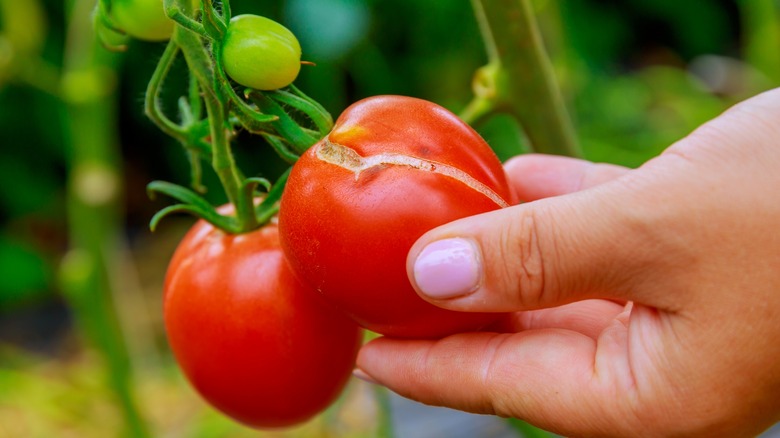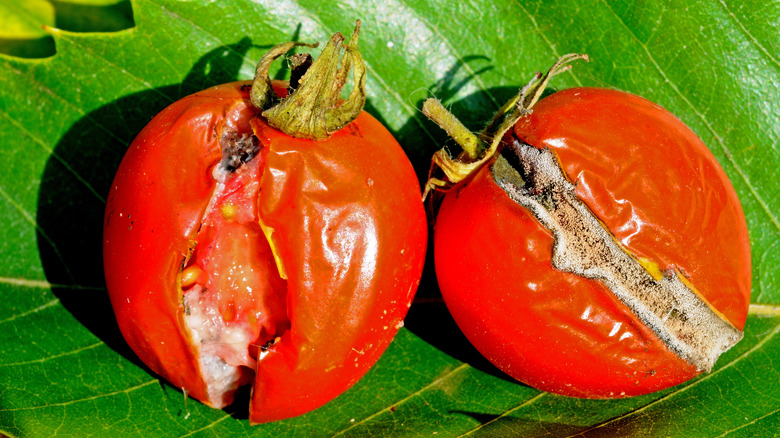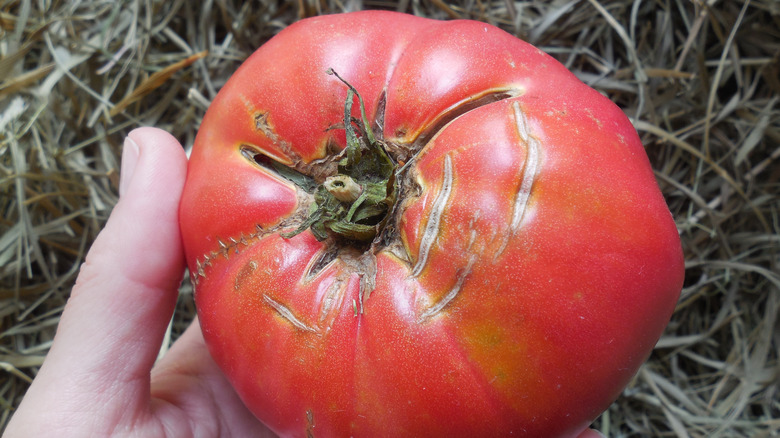Is It Safe To Eat Split Tomatoes?
Picture this: You've got a few juicy-looking tomatoes ripening on the vine. Maybe you've already got plans to turn them into a summery caprese salad — and then, boom, some of the tomato skins have started to split open. And while this may be aesthetically less-than-desirable, fear not: There's a good chance your split tomatoes are still fine to eat.
Tomatoes split in one of two ways. First are concentric cracks, which appear around the step at the top of a tomato (they're sometimes described as "horizontal," even though this might be a bit inaccurate considering tomatoes' round shape). These are generally not a problem: They're smaller and don't open up the tomato flesh to the air, so there's little chance of bugs or other nasties getting in. They often also heal over: While the brown "scars" from this may not be pretty, they're likely fine to eat.
Then there are "radial" cracks, which run vertically along the tomato — these are bigger, and can expose the inside of the tomato, allowing in bugs and bacteria. That said, it depends on the size of the crack, and how long the crack has been there (less time means less likelihood of contamination). You'll generally want to look carefully, and if there are bad signs, like rot, bugs, slime, or just a funky smell, play it safe and throw the tomato away. If not, it's probably fine to eat, although it's advisable to cut the split part off.
What causes splits, and how to deal with them
Tomatoes split when their plants are exposed to a lot of water, especially if they've been through a dry spell beforehand. As all that water is soaked up, tomatoes' interiors grow faster than their exterior, stretching the skins until they start popping open. This tends to happen more with ripe tomatoes, although it can occur with green ones, too.
As soon as you see a split, you'll want to get them off the vine so they can't keep growing and splitting more, particularly in the case of the larger, radial cracks. Don't worry if they're not ripe: As long as they've at least started to change color when you pick them, they'll continue to ripen off the vine. But be careful with green ones: If a green tomato splits, there's a higher chance it'll be rotted or inedible by the time it ripens, since it'll be exposed for longer. As mentioned, it's probably safer to cut the split parts off — if you're concerned about aesthetics, you may want to use split tomatoes for dishes like soups or a salsa where the tomatoes will be well-diced or puréed.
As a side note, you're unlikely to find split tomatoes at the grocery store, as supermarkets and big produce suppliers tend to prioritize flawless-looking vegetables. But if you do happen to find one, the above advice still applies.
How to prevent tomatoes from splitting
Even if split tomatoes are often fine to eat, all that extra inspecting and slicing may be annoying. Fortunately, there are steps that home gardeners can take to prevent them from splitting in the first place. A big one is to water your tomatoes consistently, with a deeper watering two to three times a week. Otherwise, if they dry out too much, they won't cope so well when they get a big hit of water, whether it's from you or from a thunderstorm rolling through. Putting mulch down is also wise, as it helps keep the tomato plants' moisture in check, stopping them from absorbing excessive water. After all, this is what causes the sudden growth that results in splits. Keeping them in pots with good drainage is also wise for avoiding that excess water
If you're using fertilizer, avoid one with too much nitrogen, as this also leads to that excess growth and splitting. Finally, you may want to seek out types of tomatoes that are less likely to split. There are quite a few tomato species in this category, including Roma, San Marzano, and Sun gold tomatoes, although be aware that they're not totally immune to splitting.


